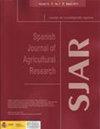Predatory insect species, and patterns of abundance of two common thrips species (Thysanoptera) and their predators on common crops
IF 0.8
4区 农林科学
Q3 AGRICULTURE, MULTIDISCIPLINARY
引用次数: 0
Abstract
Aim of study: The seasonal distributions of the western flower thrips, Frankliniella occidentalis (Pergande) and the onion thrips, Thrips tabaci Lindeman (Thysanoptera: Thripidae), as well as their primary predators, predatory bugs, Orius spp (Hemiptera: Anthocoridae), in the polyculture agricultural area were investigated in order to gain a thorough understanding of the prey-predator relationships on various crop plants. Area of study: Adana Province, located in the eastern part of the Mediterranean Region of Türkiye. Materials and methods: Thrips and predatory insects were collected from various plants using the tapping method during 2019-2020. Their diversity, seasonal densities, and distributions were investigated. Main results: A total of 11 predator species were identified, with Orius laevigatus (Fieber) and Orius niger (Wolff) being the most prevalent species. The greatest diversity of predatory insect species was found among plant species from the Fabaceae family. With the exception of field crops, T. tabaci was found to be the most frequent thrips species in the examined cultivated plants when compared to F. occidentalis on common crop plants. Among winter vegetables, a significant number of predators, primarily O. laevigatus, were only collected from broad bean plants. The abundance patterns of thrips and predatory insects were closely associated with the flowering phenology of plants. Research highlights: Strong relationships were observed between Orius spp. and T. tabaci adults. This study suggests that broad beans, a winter crop, could be included in crop rotations during the autumn-to-early spring period to support the populations of predatory insects in various ways.普通作物上的两种常见蓟马(蓟马科)及其天敌的捕食昆虫种类和丰度模式
研究目的调查西花蓟马(Frankliniella occidentalis (Pergande) )和洋葱蓟马(Thrips tabaci Lindeman)(蓟马科:Thripidae)及其主要捕食者捕食蝽(Orius spp)(半翅目:Anthocoridae)在多栽培农业区的季节性分布情况,以深入了解各种作物植物上的捕食者-捕食者关系。研究区域:阿达纳省,位于土耳其地中海地区东部。材料和方法:在 2019-2020 年期间,采用攻丝法从多种植物上采集了蓟马和捕食性昆虫。调查了它们的多样性、季节性密度和分布情况。主要结果共鉴定出 11 种天敌昆虫,其中 Orius laevigatus (Fieber) 和 Orius niger (Wolff) 是最常见的物种。在豆科植物中,捕食性昆虫种类最为丰富。除大田作物外,在所研究的栽培植物中,蓟马是最常见的蓟马种类,而在普通作物上,蓟马则是最常见的蓟马种类。在冬季蔬菜中,只在蚕豆植株上采集到大量天敌,主要是 O. laevigatus。蓟马和捕食性昆虫的丰度模式与植物的开花物候密切相关。研究亮点观察到蓟马和烟粉虱成虫之间的密切关系。这项研究表明,蚕豆是一种冬季作物,可在秋季至早春期间纳入轮作,以各种方式支持捕食性昆虫的种群。
本文章由计算机程序翻译,如有差异,请以英文原文为准。
求助全文
约1分钟内获得全文
求助全文
来源期刊

Spanish Journal of Agricultural Research
农林科学-农业综合
CiteScore
2.00
自引率
0.00%
发文量
60
审稿时长
6 months
期刊介绍:
The Spanish Journal of Agricultural Research (SJAR) is a quarterly international journal that accepts research articles, reviews and short communications of content related to agriculture. Research articles and short communications must report original work not previously published in any language and not under consideration for publication elsewhere.
The main aim of SJAR is to publish papers that report research findings on the following topics: agricultural economics; agricultural engineering; agricultural environment and ecology; animal breeding, genetics and reproduction; animal health and welfare; animal production; plant breeding, genetics and genetic resources; plant physiology; plant production (field and horticultural crops); plant protection; soil science; and water management.
 求助内容:
求助内容: 应助结果提醒方式:
应助结果提醒方式:


